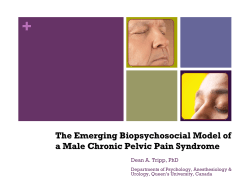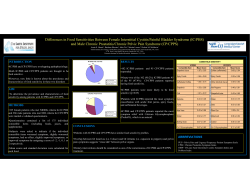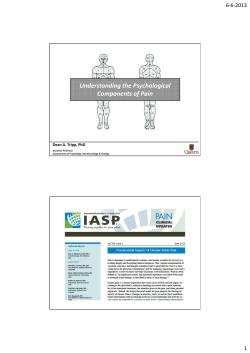
Male Chronic pelvic pain syndrome Dr. Kan Chi Fai Associate Consultant
Male Chronic pelvic pain syndrome Dr. Kan Chi Fai Associate Consultant Queen Elizabeth Hospital What patient groups are included in this topic? Prostatitis? Patients with perineal pain? Patients with LUTS? Patients with pain upon ejaculation? Patients with persistent discomfort in perineal region? • Patients with guilty feelings? • • • • • How common is the condition? • 8% of all visits to urologists and 1% of all primary care physicians annually in USA • Population based prevalence of prostatitis symptoms 8.2% (2.2-9.7%) – If validated National Institutes of Health Chronic Prostatitis Symptom Index (NIH-CPSI) used: • • • • Nigeria: 12.2% Malaysia: 8.0% Canada: 6.6% Singapore: 2.7% National Institutes of Health classification (1999) I. Acute bacterial prostatitis II. Chronic bacterial prostatitis (~5-15%) III. Chronic pelvic pain syndrome (CPPS) A. Inflammatory CPPS B. Non-inflammatory CPPS IV. Asymptomatic inflammatory prostatitis Stamey’s four glass test Diagnosis • No “gold standard” diagnostic test • Pain – perceived in perineum, suprapubic area, penis testes, groin or even lower back • Absence of other lower urinary tract pathology – – – – Urinary tract infection Urogenital cancer Urethral stricture Neurogenic bladder • Minimum of 3 out of the past 6 months Other associations • Lower urinary tract symptoms • Sexual function – Pain upon ejaculation – Erectile dysfunction • Psychological • Social factors Investigation • Urethral swab, urine culture and Stamey’s 4-glass test • Uroflowmetry • PSA in selected patients with LUTS • NIH-CPSI ✗Semen Culture ✗Prostate imaging ✗Cystoscopy without hematuria Etiology • No single aetiological explanation • Infection – E Coli, Enterococcus – Altered prostatic host defense • Pelvic floor muscle abnormalities • Genetic, anatomical, neuromuscular, endocrine • Psychological mechanisms Symptom assessment • NIH Chronic prostatitis collaborative research network • Three important domains – Pain – Urinary function – Quality of Life or impact NIH - CPSI Treatment • Expectation of treatment outcome • Review of previous treatment history • Multi-modality treatment • A long journey Treatment options • Antibiotics • Alpha-blockers • NSAIDs 1. Antibiotics • Fluoroquinolones / co-trimoxazole • 4-6 weeks for chronic bacterial prostatitis • Role for CPPS – ?placebo effect – ?Eradication or suppression of noncultured microorganisms – ?Independent anti-inflammatory effects in some antibiotics • Systemic review and network meta-analysis (Anothaisintawee, JAMA 2011) – Total symptom scores (-9.8; 95% CI, -15.1 to -4.6) – Pain scores (-4.4; 95% CI, -7.0 to -1.9) (total: 21) – Voiding scores (-2.8; 95% CI, -4.1 to -1.6) (total: 10) – QOL scores (-1.9; 95% CI, -3.6 to -0.2) (total: 12) • Antibiotics may be considered for antibiotics naïve patients with recent diagnosis of CP / CPPS, regardless of culture results • Avoid for previously treatment with CPPS of long duration • Leukocytes and culture results do not predict treatment outcome 2. Alpha blockers • Associated with lower urinary tract symptoms • May be related to poor relaxation of bladder neck • May diminish intraprostatic ductal reflux Efficacy • Improvement only in men with recent onset disease and on therapy more than 6 weeks • Class effect • Beneficial effect may wean off next 6 monhts after discontinuation – Total symptom scores (-1.7; 95% CI, -2.3 to -0.5) – Pain scores (-1.1; 95% CI, -1.8 to –0.3) (total: 21) – Voiding scores (-1.4; 95% CI, -2.3 to -0.5) (total: 10) – QOL scores (-1.0; 95% CI, -1.8 to -0.2) (total: 12) Combination with alpha-blockers and antibiotics • Total symptom scores (-13.8; 95% CI, -17.5 to 10.2) • Pain scores (-5.7; 95% CI, -7.8 to -3.6) (total: 21) • Voiding scores (-3.7; 95% CI, -5.2 to -2.1) (total: 10) • QOL scores (-2.8; 95% CI, -4.7 to -0.9) (total: 12) 3. NSAID • Decrease prostatic inflammation – Leukocytes in prostatic secretion / semen – Elevated cytokine in semen • Early studies showed improvement in dysuria, strangury and painful ejaculation (Canale, 1993) • Only two RCTs: Rofecoxib (out of market) and celecoxib (Zhao Braz J Med Bio Res) – Total score: -3.4 – Pain and QOL improvement; not urinary subscore – Loss of benefit after stopping the drugs for 2 weks • Meta-analysis pooled the results of these two RCTS – Anti-inflammatory drugs were 80% more likely to have a favourable response than placebo Recommendation of other agents in EAU guideline • Opioids – Modest pain relief in some refractory condition – Risk of addiction, side effects, reduced QOL • 5-alpha reductase inhibitors – No studies powered to show the benefit • Allopurinol – No benefit noted in RCT / Cochrane library review • Muscle relaxants – Studies poorly documented the response – Use in combination with alpha blockers / antibiotics If these agents do not work… • Phytotherapy • Pentosan polysulphate • Extracorporeal shock wave therapy • Posterior tibial nerve stimulation • Psychological treatment Phytotherapy • Pollen Extracts – Prostat/Poltit(Elist, 2006) – Cernilton (Wagenlehner, 2009) – Reduction in inflammatory markers in rats • Quercetin (Bioflavonoid) (Shoskes, 1999) – Antioxidant – tyrosine kinase inhibitor – anti-inflammatory • Pain score improvement: 2-3 • Voiding score improvement: 0.8-1.5 • Minimal side effects – Headache – Tingling of the extremities – Reversible Pentosan polysulphate • A drug used in interstitial cystitis in female • Usual dose in interstitial cystitis: 300mg daily • Acted as a protective barrier in the urinary tract • RCT with 16 week 900mg PPS vs placebo (Nickel, J Urol 2005) • Improvement in – clinical global improvement ~19% – NIH-CPSI ~10% (but p =0.068) • Diarrhoea / nausea /headache • One patient (1 out of 50) has impaired liver function Extracorporeal shock wave therapy • Low intensity shockwave using a perineal approach without anesthesia – Duolith SD1, Storz Medical – Weekly treatment – 3000 pulses, maximum total energy flow density: 0.25mJ/mm2 , for 4 weeks – Electromagnetic shock wave – Penetration: 35-65mm • Proposed mechanisms – Interrupting the flow of nerve impulses by hyperstimulation of nociceptors – Healing of tissue by revascularization processes – Reduction of muscle tone and spasticity (Vahdatpour, IRSN Urology, 2013) RCT from Zimmermann (Eur Uro 2009) • Pain – VAS: 33% in 1 week and 50% after 4-12 week • NIH-CPSI: - 17% in 12 week • Erectile Dysfunction – IIEF: 5.3% in 1 week and 10.5% in 12 week • Voiding condition – IPSS: 15% in 1 week and 25% in 12 week • No side effects (perineal pain / voiding problem) • Short term data available Percutaneous tibial nerve stimulation • Neuromodulation • 26G stainless steel needles inserted 5cm cehaland from the medial malleolus &posterior to the edge of the tibia • Pulse rate 20Hz • 12 weeks, 30 min each Kabay, Urol Int 2009 • • • • Effective in short term Improved urgency Avoid implanting electrode Minimal side effects • ?Maintenance therapy Kabay, Urol Int 2009 Psychological treatment • Psychological status is also targeted as • As many as 78% of patients reporting depression and 60% having met criteria for a major depressive disorder • Greater depression and not having a partner for support were associated with poorer CPPS outcome • A feasibility study for 8 session self-management program – Provider workbook: patient tasks and agenda topic – Urology nurse/ equivalent health care worker: leading the one-hour weekly session – Manage patient burden or confusion – Starting the value of the cognitive and behavioural approach used in the program – Practice positive communication – Revise risk factors modifications • Improvement in NIH-CPSI score 7.25 – Pain domain 3.38 points – QOL impacy domain – NOT in urinary domain • Risk factor reduction esp. reduction in catastrophizing were most associated with score improvement Take home messages • CPPS in male is a common problem and has multi-factorial causes • NIH-CPSI as a useful tool to measure the pain, urinary and QOL / impact domains • Antibiotics and alpha blockers are effective treatments but mainly for patients with short duration of disease and are treatment naïve • Phytotherapy, pentosan polysulphate, extracorporeal shock wave therapy, posterior tibial nerve stimulation and psychological treatment can be helpful in CPPS management in different domains
© Copyright 2025





















